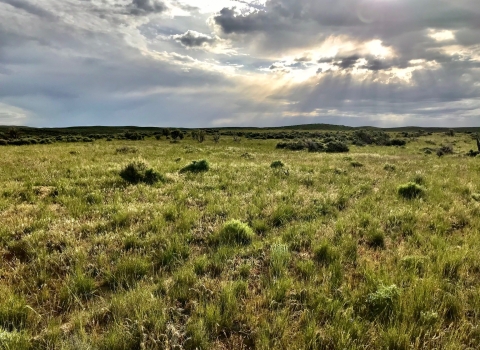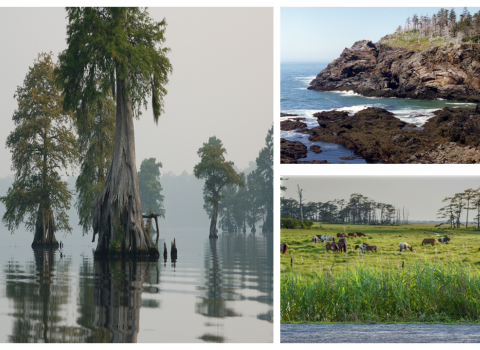Denver, CO – The U.S. Fish and Wildlife Service today announced $10 million in fiscal year 2023 funds from President Biden’s Bipartisan Infrastructure Law Bipartisan Infrastructure Law
The Bipartisan Infrastructure Law (BIL) is a once-in-a-generation investment in the nation’s infrastructure and economic competitiveness. We were directly appropriated $455 million over five years in BIL funds for programs related to the President’s America the Beautiful initiative.
Learn more about Bipartisan Infrastructure Law to support over 50 projects in western states to restore and conserve strategic areas within the sagebrush sagebrush
The western United States’ sagebrush country encompasses over 175 million acres of public and private lands. The sagebrush landscape provides many benefits to our rural economies and communities, and it serves as crucial habitat for a diversity of wildlife, including the iconic greater sage-grouse and over 350 other species.
Learn more about sagebrush ecosystem.
Projects were based on the Sagebrush Conservation Design, which provides a roadmap for addressing threats to sagebrush by facilitating cooperative conversations that enable stakeholders to work together. The design calls for a ‘Defend and Grow the Core’ approach, flipping the script by focusing first on intact core sagebrush habitats, and then growing the cores outward to restore more degraded areas. Selected projects will combat invasive grasses and associated wildfire threats, reduce encroaching conifers, safeguard precious water resources for neighboring communities and wildlife, and promote community and economic sustainability.
“Sagebrush country, which is a national treasure, supports American agriculture, outdoor recreation, and hundreds of species that live nowhere else in the world,” said Service Director Martha Williams. “This ecosystem serves as the lifeblood for many rural and Tribal communities in the West. We are proud of the work we were able to accomplish last year through the first round of Bipartisan Infrastructure Law funding, and look forward to continuing collaborative efforts to conserve the sagebrush ecosystem and the significant biological, cultural and economic resources it supports.”
Spanning over 175 million acres, sagebrush country contains biological, cultural and economic resources of national significance. It is home to more than 350 species across the West, including pronghorn, elk, mule deer and greater sage grouse. America’s sagebrush ecosystem is the largest contiguous ecotype in the U. S., comprising one-third of the land mass of the lower 48 states.
Through the Bipartisan Infrastructure Law, the U.S. Fish and Wildlife Service was appropriated $10 million per year for five years, to expand work with partners to conserve the sagebrush ecosystem. Projects are helping to create good-paying jobs that strengthen local economies and furthering the strong working relationships between the Department, states and Tribes in these landscapes.
Examples of fiscal year 2023 projects include:
Pre- and Post-treatment Impacts of Japanese Brome Treatment on Pollinators in Sagebrush Rangeland (MT), $70,000 - Japanese brome infestations are present within sagebrush core and growth areas of the Charles M. Russell National Wildlife Refuge. Herbicidal treatment sites will be paired with untreated Japanese brome invaded sagebrush areas and sagebrush areas with native dominated understory to determine effectiveness of restoration efforts and non-target impacts of the treatments. This work will complement ongoing work on the response of sagebrush obligate songbirds to invasive annual grass treatments.
Wyoming Invasive Annual Grass Management Collaborative (WY), $750,000- A multi-year partnership between the Service, the State of Wyoming, Eastern Shoshone and Northern Arapaho Tribes, USDA, local governments and other entities to control invasive annual grasses and defend approximately 100,000 acres of high‐quality sagebrush habitat on mixed‐ownership lands in Wyoming through on‐the‐ground treatments.
Gunnison Basin Cheatgrass and Wet Meadow Implementation Project (CO), $95,337 – Through this ongoing project, the Service is helping further long‐term sagebrush efforts with strategic collaborative conservation action. Funding will support delivery of tangible outcomes involving wet meadow restoration, prioritized cheatgrass treatments, and sagebrush restoration within the Gunnison Basin of Colorado.
Utah Field Team Conifer Treatment Projects for Upland Habitat Restoration and Enhancements (UT), $250,000 – The Service is continuing funding to support upland habitat restoration in Utah. Removing conifers is an effective restoration tool in these systems and is necessary for defending and growing the core sagebrush habitats in this state.
See a full list of fiscal year 2023 projects on our Sagebrush Conservation website.
The Service is committed to working with local communities, state and federal agencies, Tribes, conservation groups and private sector partners to ensure they have the tools they need to conserve these important areas. Sagebrush funding is allocated to existing and new projects based on priorities established by the Service’s Sagebrush Ecosystem Team (SET) and partners, including the Western Association of Fish and Wildlife Agencies (WAFWA). The SET, WAFWA and others are employing a collaborative approach to defend and grow intact, functioning sagebrush geographies and mitigate the primary threats to sagebrush ecological health, namely invasive grasses and wildfire, drought and encroaching conifers. By anchoring conservation in these areas, the Service and its partners can focus on working to restore degraded lands and habitat through the “Defend the Core, Grow the Core” approach endorsed by the Western Governors Association.
These projects will help support the America the Beautiful initiative to conserve, connect and restore our nation’s lands, waters and wildlife.
– FWS –
The U.S. Fish and Wildlife Service works with others to conserve, protect, and enhance fish, wildlife, plants, and their habitats for the continuing benefit of the American people. For more information, visit www.fws.gov, or connect with us through any of these social media channels: Facebook, Instagram, Twitter, Flickr, and YouTube.




